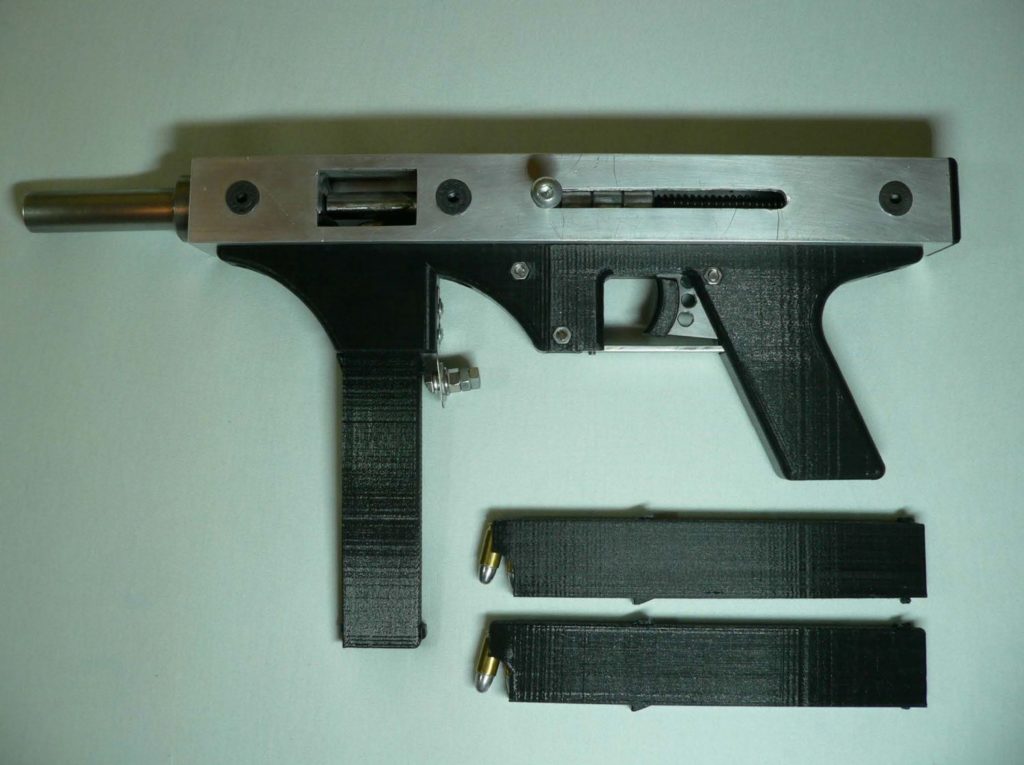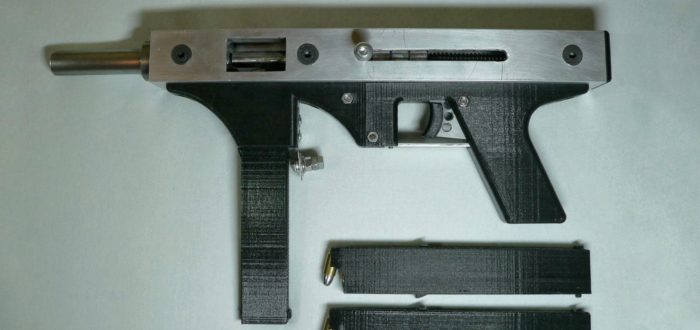Chloe Tousignant
Philip A. Luty was a British designer of homemade firearms. Whilst he did not consider himself an activist, he held strong beliefs in favour of universal firearms ownership and expressed these via his website and other platforms. As a form of political protest, Luty sought to widely disseminate plans for firearms. Luty designed a number of craft-produced firearms, most notably four distinct sub-machine gun designs. His book Expedient Homemade Firearms gives detailed instructions on how to build the most widespread of these using readily available parts that can be purchased at a hardware store. Although the title suggests these weapons are easily made, their production still requires some knowledge and metalworking skill. As ARES Technical Specialist Jonathan Ferguson writes:
Readers should not assume that Luty’s efforts have made homemade firearms easy to produce. In fact, they remain quite sophisticated pieces of engineering. Despite Luty’s label of ‘expedient’, his guns are in fact true ‘craft-produced’ weapons, replicating the features (if not the quality, accuracy or reliability) of an original-purpose firearm. For this reason, they require considerable skill to replicate successfully. Further, the manufacturer must also obtain quantities of suitable ammunition. In any case, although Luty pattern weapons have appeared in other parts of the world (for example in Romania and Australia), criminals in the UK do not appear to have made any great use of them.
As with other historical craft-produced firearms, these weapons may be subject to frequent malfunctions if not built with sufficient skill. The almost universal use of unrifled barrels on such designs means that accuracy is poor and range severely limited. Nonetheless, in areas where industrially manufactured small arms are not readily available, criminals and other users have found these types of weapons appealing.


The design drawings prepared by Luty are still widely available on the internet today and have inspired numerous copycat designs from around the world. Luty sub-machine guns can be found globally and have been documented with criminal groups in Australia, Brazil, Romania, Sweden, Ecuador, and the United Kingdom; with terrorist organisations in Indonesia; and used by an extremist individual in Germany. Luty’s designs are not the only craft-produced sub-machine guns to have proliferated, of course. A design known locally as the ‘Carlo’ has been used in attacks in Israel and the Palestinian Territories, for example. As with many crude sub-machine gun designs around the world, the Carlo shares a common calibre and a general visual similarity with the Luty, despite varying in the details of its design. As a result, it can sometimes be difficult to determine whether a given design was directly inspired by Luty, without close physical inspection. Nonetheless, there are several cases in which close copies have been produced, most likely following his written plans.
In Brazil, for example, Luty-type weapons are sold for approximately 2,500 USD. The Luty is only one of many designs in that country, where craft-produced SMGs are common. In fact, it was reported that between 2011–2012 nearly half of the sub-machine guns seized by police in Sao Paulo were homemade. Large ungoverned spaces in Brazil have enabled more widespread craft-production than elsewhere and this has led to the rise of several variations of Luty’s design. Smaller numbers have been documented in neighbouring Ecuador, according to ARES sources.
In Australia, close copies of Luty’s original design have commanded as much as 15,000 AUD on the black market. Whilst in many countries criminal groups have been seen to produce Luty sub-machine guns for their own use, in Australia most examples appear to have been produced by enterprising individuals. According to Australian police and media reports, these weapons are often sold to organised crime groups such as outlaw motorcycle gangs. Craft-produced designs are frequently connected to the Australian drug trade and have accounted for 10% of police firearms seizures in some states.
In November 2016, Queensland police raided several homes and businesses along the Gold Coast. In addition to recovering drug-making paraphernalia, they also found what they described as “sophisticated” gun-making equipment including computers, a 3D printer, drill presses, and other tools and firearms components. A Luty described by the media as 3D-printed was, however, a conventionally produced example with no visible 3D-printed components. However, such parts have been developed for the Luty elsewhere.
In October 2019, the synagogue in Halle was attacked by an antisemitic extremist gunman who used improvised and craft-produced firearms. Two Luty-type SMGs were included in his arsenal. One was conventionally produced, presumably following Luty’s plans, whilst the other featured a 3D-printed lower receiver and magazines. The latter was not used during the attacks, but the conventional model suffered several malfunctions. The shooter was not impressed with his designs, at one point saying, “I have certainly managed to prove how absurd improvised weapons are”. The issues experienced by the Halle shooter are in many ways indicative of broader challenges faced by the producers and users of craft-produced weapons. As craft-produced firearms developer and researcher Ivan T. told ARES:
While functional examples of the Luty have turned up worldwide, there is much misunderstanding surrounding the perceived difficulty of manufacturing such a firearm. The Luty relies on its maker to have a certain level of skill with hand tools that most people simply lack. There’s an art of ‘hand fitting’ in making craft-produced firearms, where the maker must understand how physical parts must fit together in order to attain reliable function—the Luty, especially its magazine, requires careful hand-fitting of many parts. While Luty made a good attempt at writing instructions on how to ensure reliable function, most of his advice is not of much use to someone unfamiliar with the use of hand tools such as saws, metal files, and pliers.


That the hybrid 3D-printed Luty was not used by the Halle attacker may be telling. Research indicates it was a novel design that is not known to be circulating within major online design-sharing sites. ARES Director N.R. Jenzen-Jones said:
As we know, the shooter tried using some of the 3D-printed magazines in his primary (non-3D-printed) Luty during the attack, and encountered issues with them. This could have been the magazines, the gun, the ammunition, or a combination of these factors. In any case, both the 3D-printed lower and the magazines are unproven designs, and our research shows they are not shared through major online channels. One of our contacts said: “I don’t think you need be near ‘professional’ level to print any of what the shooter did – while it’s evident he did design some of the stuff at least partially himself, the actual printing and fabrication of that stuff isn’t terribly complex.”
3D-printed firearms are developing rapidly, however, and there are now a number of proven designs which are readily available. These are frequently ‘hybrid’ or ‘parts kit completion’ (PKC) designs which use a combination of restricted or unrestricted metal components and 3D-printed polymers. The first widespread, viable 3D-printed semi-automatic firearm design was called the Shuty MP-1, in an obvious nod the Luty’s work. Later models are even more capable. ARES’ recent report, Desktop Firearms: Emergent Small Arms Craft Production Technologies, gives a comprehensive assessment of the current state of the technology. One critical development covered in the report is the use of electrochemical machining (ECM) to rifle barrels. The relative ease of 3D-printing and the ability to rifle barrels could signify a new future for homemade weapons.
In some ways, these recent developments may be attributable to Luty and others like him. The new generation of 3D-printed firearms—especially hybrid designs and PKC builds—overcome many of the technical challenges a would-be home weapons maker faces. Ivan T. continues:
Luty’s ideological approach has inspired improvements to his general idea of a firearm made from unregulated parts—with the advent of affordable, compact, and user-friendly fabrication tools like 3D printers and desktop CNC machines, many of the issues a maker of the Luty design faces can be avoided, or even resolved. Of particular relevance is the question of reliable magazines. Many firearms designs are hobbled by their need for reliable, production-friendly magazines. The Luty is no exception—its magazines stand as perhaps the weakest part of the overall design, and require significant hand fitting to work properly. With 3D printing, however, production of reliable magazines on the individual level becomes trivial. 3D-printed GLOCK double-stack 9x19mm magazines have been demonstrated to feed reliably, even in automatic firearms, and require no special know-how to manufacture beyond setting up a 3D printer.

It remains to be seen whether, in the short term, Luty’s design will be augmented by new technologies (e.g. 3D-printed components, ECM-rifled barrel), or whether it will simply be supplanted by new, easier-to-produce weapons such as the FGC-9. According to Hays & Jenzen-Jones (2018), non-state armed groups have historically sought to replace improvised and craft-produced systems with conventionally manufactured weapons of a higher standard. 3D-printed hybrid/PKC firearms may, in some cases, provide an interim step. Two of the Luty design’s chief advantages—the availability of plans and the unrestricted nature of its components—are being rapidly undermined by the rise of advanced 3D-printed designs. An example of Luty’s “Expedient 9mm Submachine Gun”, along with copies of plans found online, was exhibited by artist Cameron MacLeod at the Dortmund Bodega art space in Oslo, Norway in 2011. Perhaps, in the not-too-distant future, museums and galleries will be the primary custodians of these pieces of firearms history.

Technical Specifications
Calibre: 9 ? 19 mm
Overall length: 538 mm
Barrel length: 229 mm
Weight (unloaded w/ empty magazine): 3.52 kg
Feed device: detachable box magazine
(Ferguson, 2017).

Sources
Ferguson, Jonathan. 2017. ‘P.A. Luty 9 mm sub-machine guns’. The Hoplite (ARES company blog). 13 August. <http://armamentresearch.com/pa-luty-9mm-submachine-guns/>.
Hays, G. & N.R. Jenzen-Jones. 2018. Beyond State Control: Improvised and Craft-produced Small Arms and Light Weapons. Geneva: Small Arms Survey. <http://www.smallarmssurvey.org/fileadmin/docs/U-Reports/SAS-improvised-craft-weapons-report.pdf>.
Hays, G., Ivan T. & N.R. Jenzen-Jones. 2020. Desktop Firearms: Emergent Small Arms Craft Production Technologies. Perth: Armament Research Services (ARES). <http://armamentresearch.com/wp-content/uploads/2020/03/ARES-Research-Report-8-Desktop-Firearms.pdf>.
Improguns. 2016. ‘Semi-automatic firearm produced using 3D printer’. The Hoplite (ARES company blog). 10 February. <http://armamentresearch.com/semi-automatic-firearm-produced-using-3d-printer/>.
Luty, P.A. 1998. Expedient Homemade Firearms. Boulder, CO: Paladin Press.
McCollum, Ian. 2017. ‘Weapons as Political Protest: P.A. Luty’s Submachine Gun’. YouTube video. 2 August. <https://www.youtube.com/watch?v=sIhGCRIQnCA>.
T., Ivan. 2020. Correspondence with ARES. 16 May.
Remember, all arms and munitions are dangerous. Treat all firearms as if they are loaded, and all munitions as if they are live, until you have personally confirmed otherwise. If you do not have specialist knowledge, never assume that arms or munitions are safe to handle until they have been inspected by a subject matter specialist. You should not approach, handle, move, operate, or modify arms and munitions unless explicitly trained to do so. If you encounter any unexploded ordnance (UXO) or explosive remnants of war (ERW), always remember the ‘ARMS’ acronym:
AVOID the area
RECORD all relevant information
MARK the area from a safe distance to warn others
SEEK assistance from the relevant authorities

